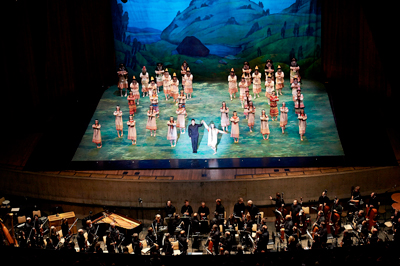by Daniel Hathaway
For their third Blossom collaboration under conductor Tito Muñoz, Chicago’s Joffrey Ballet and The Cleveland Orchestra brought four scores composed within the last hundred years to the pavilion stage at the Blossom Music Center on Saturday evening, August 17 (to be repeated on Sunday evening).
Two were newly-minted contributions to the dance repertoire. Stanton Welch choreographed John Adams’s Son of Chamber Symphony (2007) in 2012 for Jacob’s Pillow — the original commission, entitled Joyride, involved Stanford University, Carnegie Hall, and the San Francisco Ballet, with choreography by Mark Morris. And Aram Khachaturian’s Adagio, a pas de deux from Spartacus (1954) was refashioned from the original ballet by Yuri Possokhov for the 2012 Napa Valley Festival de Sole.
Two were twentieth-century classics. Jerome Robbins’s 1945 Interplay was set to Morton Gould’s 1943 American Concertette. And Igor Stravinsky’s Le sacre du printemps had its famous, riotous debut in Paris a hundred years ago last April.
Part of the fun of experiencing ballet at Blossom is the informality of its presentation. When you take your seat, dancers are milling about and flexing their legs on the darkened stage wearing warmup suits. There’s no scenery (a backdrop was unfurled only for Sacre) and whatever ambiance is to be had is created through lighting. That’s pretty basic too. Between pieces, stagehands came on to change the gels in cans that washed the walls of the Blossom shell in different colors.
The absence of distractions allows the audience to concentrate on the movement and the music — and who needs more than that with such an accomplished company as the Joffrey onstage and such a superb ensemble as The Cleveland Orchestra in the pit?
Interplay’s four movements — Free-Play, Horse-play, By-Play and Team-Play — provided the Joffrey dancers with a wealth of opportunities for joyous responses to Morton Gould’s cheeky, effervescent music, further animated by high energy concertato piano playing by Joela Jones. Fine ensemble work, an engaging mix of classical ballet gestures and 1940s, swing-inspired moves punctuated by hand claps and finger snaps, featured arresting solo moments and duets by John Mark Giragosian and Christine Rocas and Alberto Velazquez. Athletic to the core, the ballet ended with the men diving through the women’s legs.
Adams’s nervous, twitchy music inspired similarly quirky choreography in Son of Chamber Symphony, a catalog of takeoffs on classical ballet situations with surprising twists: the single, trembling tutu Anastacia Holden wore in the first movement multiplied to six in the last, when references to stock gestures and costumes became increasingly alien and strange. Blossom’s critters added an obbligato to the second movement duet, finely modeled by April Daly and Dylan Gutierrez, that seemed to fit in perfectly.
A high point of the first half was Victoria Jaiani and Temur Suluashvili’s sensuous, intertwining duet in Adagio, a perfect response to Khachaturian’s opulent music. The audience responded with a long ovation.
The big draw of the evening, of course, was Rite of Spring, danced in a 1987 reconstruction of Vaslav Niijinsky’s original choreography by dance historian Millicent Hodson and Robert Joffrey, with original costumes by Nicholas Roerich reconstructed by Kenneth Archer. No reconstruction was needed for Stravinsky’s score, which, unlike the choreography, never got lost, though the Blossom performances made use of a sanctioned reduction for theatrical productions by Jonathan McPhee.
A greater disconnect from classical ballet than Nijinsky’s innovative, primitive choreography would be difficult to imagine, and seems to have fueled the discontent of the first night audience for Sacre far more than Stravinsky’s equally iconoclastic score. Even a hundred years and four months after its premiere, the choreography retains some shock value. The opening scenes after the orchestral introduction might have sprung just as easily from the brain of Monty Python as Vaslav Nijinsky.
Once you acclimatized yourself to the highly stylized movement patterns of the pointy-hatted peasants, however, the dance made perfect sense with the music. The Joffrey dancers masterfully synchronized their flat-footed, stomping motions to Stravinsky’s complicated rhythms and their organized hysteria was marvelous to behold. Joanna Wozniak delivered her frenzied dance of sacrifice as the Chosen One with ritualistic commitment. The final moment when the men suddenly lifted her body aloft crowned a wonderful thirty-six minutes of dance.
Those of us who are used to hearing Sacre as an orchestral tour de force may have been surprised with some of the more utilitarian tempos dance imposed on the piece. Tito Muñoz led his forces with precision and flair. No wonder he’s become a favorite with the Joffrey company.
Photo by Roger Mastroianni.
Published on ClevelandClassical.com August 13, 2013
Click here for a printable version of this article.




